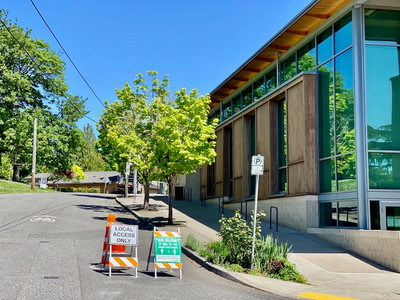New Trees Planted
- Hillsdale News
- Feb 10, 2022
- 3 min read
[Updated Friday, February 11, 2022]
Update
New trees have been planted in front of the Hillsdale Library to replace the ailing ones that were removed last year.

Along Sunset Blvd. are three Forest Green Oaks (Quercus frainetto 'Schmidt'. Dewitt St. now has new three Ginkgo biloba trees, variety 'Autumn Gold,' also known as Maidenhair Tree. Says branch manager Patti Vincent, "We are all looking forward to seeing leaves popping out before long."
Keep your eyes peeled for signs of browsing dinosaurs once the trees leaf out (if this references makes no sense to you, scroll down to see what it's all about).
Hillsdale Library to Get New Street Trees
[Posted Friday, July 2, 2021]
The maples planted outside the Hillsdale Library had been limping along for years, says the arborist contracted by Multnomah Library to care for them.
The dead and dying trees were removed earlier this week to make way for new trees that are better suited to the conditions of the site.
Before (photo taken in May of 2020) and after (photos taken on Sunset and on Dewitt after trees were removed)
Jay Hadley, manager of the library branch, says the empty tree wells will be replenished with fresh soil and new trees will be planted this fall. Oaks will be planted on Sunset and ginkgos on Dewitt.
The new trees, while not native species, will be more drought tolerant and more appropriate to the urban conditions.

The arborist says the oak species that has been selected is Quercus frainetto ‘Forest Green’, common names include Hungarian Oak or Italian Oak. Online resources describe it as an upright growing, vigorous tree that is very attractive in summer. It is a deciduous tree with good fall color and insignificant flowers that develop into small acorns. 'Forest Green' grows to 50 feet tall and up to 30 feet wide.
The ginkgo tree is similar in size to the oak species slated to become its around-the-corner neighbors. Also deciduous, the ginkgo is widely known as a beautiful landscape tree. Only male ginkgos, which don’t produce fruit or the mess that goes along with them, are sold for use in the landscape.
But there are a few other features of the ginkgo that deserve our attention.
Ginkgo biloba is the lone modern relic of a large group of plants that emerged in the Triassic period, the beginning of the age of the dinosaurs. Its unique history and distinct features make it not just a pretty plant, but a throwback to prehistoric times that is still very important to humans today.
Ginkgos, along with another prehistoric group of plants called cycads, are the only plants living today with swimming sperm, similar to those of humans. Their fan-shaped leaves don’t look like any other leaf around today.
Only a few species from this group survived the End-Cretaceous extinction, the event that included the demise of the non-bird dinosaurs including, sadly, all your faves—T. rex, Stegosaurus, Triceratops, etc. After that, the ginkgo disappeared from the fossil record of the southern hemisphere, but remained in the northern hemisphere. Its geographic distribution mysteriously and rapidly shrank until, by the end of the last Ice Age, ginkgo survived only in China as the single species Ginkgo biloba, making it an evolutionary orphan, the only survivor of a once-diverse group.
The tree was a hit in China, where it has been cultivated for at least a thousand years and continues to be an important cultural, medicinal and food item to the present day in Korea and Japan, as well as China. It’s staggering to realize that without the attention and care Ginkgo biloba has received in these cultures over the last few centuries, it likely would have gone the way of its relatives (and the dodo). Snatched from the jaws of extinction, the ginkgo has found its place as a landscape plant worldwide.
Because its relatives were many, many times more diverse and numerous during the time of the dinosaurs, the ginkgo's strange appearance is a small glimpse into ancient ecosystems usually only accessible through fossils. Next time you see one, maybe it will help you imagine an ancient landscape of strange plants, and even the dinosaurs who ate them, in the midst of Hillsdale.
Ginkgo leaf (www.smithsonianmag.com/smart-news/thousands-year-old-ginkgo-trees-genetic-elixir-life-180974004/) . Ginkgo in fall colors ucanr.edu/blogs/blogcore/postdetail.cfm?postnum=14247). Ginkgo in summer colors (source: www.plantingtree.com/products/ginkgo-tree).
--Valeurie Friedman, with contributions from Kendra Autumn
What do you think? Let us know.











